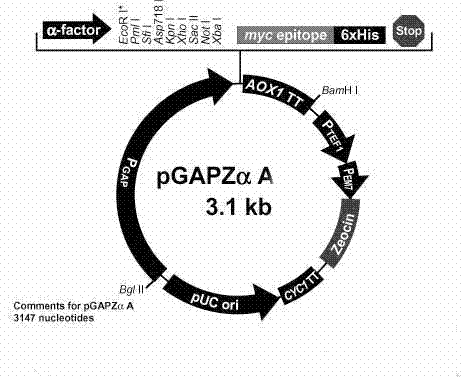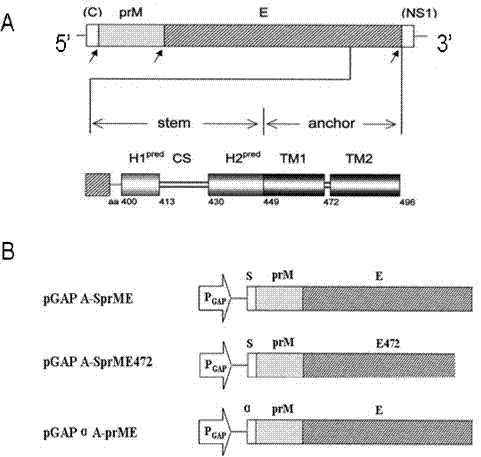Dengue virus (DENV)-like particle as well as preparation method and application thereof
A dengue virus, virus-like technology, applied in the field of genetic engineering, can solve the problems of secreting and expressing four types of dengue virus virus-like particles that have not yet been found, and achieve the effect suitable for large-scale production
- Summary
- Abstract
- Description
- Claims
- Application Information
AI Technical Summary
Problems solved by technology
Method used
Image
Examples
Embodiment 1
[0033] Example 1 Determination of the optimal construction strategy for DENV1-4VLPs gene expression elements
[0034] 1. DENV1~4 virus culture and virus RNA extraction
[0035] DENV-1 GZ01 / 95 strain, DENV-2 ZS01 / 01 strain, DENV-3 H87 strain and DENV-4 H241 strain were respectively inoculated on C6 / 36 cell monolayer, and cultured in MEM containing 2% inactivated calf serum cultured at 37°C until the appearance of cytopathic changes reaching "+++~++++", and the supernatant was collected for RNA preparation. Total RNA was extracted from the culture supernatant using Trizol reagent. Trizol ? LS reagent is a product of Invitrogen, USA.
[0036] 2. Preparation of DENV1-4 prME gene elements
[0037] Using ThermoScript TM RT-PCR System (Invitrogen, USA) reverse-transcribed DENV1-4 RNA to synthesize the first strand of cDNA.
[0038] Reaction system: template RNA (5-10 μg) 8 μl, primer R 2 μl, dNTPs (100mM) 2 μl, DEPC water 3 μl. The total volume was 15 μl. The a...
Embodiment 2
[0042] Example 2 Construction and Identification of Recombinant Vectors Capable of Secreting and Expressing DENV1-4 VLPs
[0043] 1. Construction of recombinant vector
[0044] The prME gene prepared in Example 1 was double digested with Bsp119 I and Xba I, and the target fragment was recovered, and directional ligated with the pGAPZαA vector (product of Invitrogen Company) through the same double digestion, and the ligated product was transformed into E. coli DH5α (product of Stratagene, USA) competent cells, single clones were picked and inoculated in LB medium containing antibiotics and cultured overnight at 37°C with shaking. The correctly identified plasmids were selected and named: pGAPZ-α-PrMED1, pGAPZ-sPrME472-D2, pGAPZ-sPrME-D3 and pGAPZ-sPrME-D4, and the correctly identified recombinant vectors were transformed into P. pastoris yeast cells to obtain stable The expressed engineering bacteria were respectively preserved in the Chinese Type Culture Collection Cente...
Embodiment 3
[0055] Example 3 Preparation and Identification of DENV1~4VLPs
[0056] 1. Separation of virus-like particles by sucrose density gradient centrifugation
[0057] Harvest the cultured yeast cells, use 10-50% sucrose density gradient ultracentrifugation to purify the DENV1-4 VLPs in the supernatant of the cell lysate, absorb 30-40% of the flocculent virus-like particle layer for SDS-PAGE and Western Blotting detection. Figure 7 It is the Western blot identification chart of purified VLPs.
[0058]2. Detection of virus-like particles by electron microscopy
[0059] The solution layer containing virus-like particles obtained by the above purification method was observed by negative staining electron microscope, as shown in Figure 8 As shown, both 30 nm and 55 nm diameter VLPs were detected. Use the anti-DENV-2 serum of certain dilution concentration to carry out immunoelectron microscope observation, such as Figure 9 , VLPs with diameters of 30 nm and 55 nm were also...
PUM
| Property | Measurement | Unit |
|---|---|---|
| diameter | aaaaa | aaaaa |
| diameter | aaaaa | aaaaa |
Abstract
Description
Claims
Application Information
 Login to View More
Login to View More - R&D
- Intellectual Property
- Life Sciences
- Materials
- Tech Scout
- Unparalleled Data Quality
- Higher Quality Content
- 60% Fewer Hallucinations
Browse by: Latest US Patents, China's latest patents, Technical Efficacy Thesaurus, Application Domain, Technology Topic, Popular Technical Reports.
© 2025 PatSnap. All rights reserved.Legal|Privacy policy|Modern Slavery Act Transparency Statement|Sitemap|About US| Contact US: help@patsnap.com



